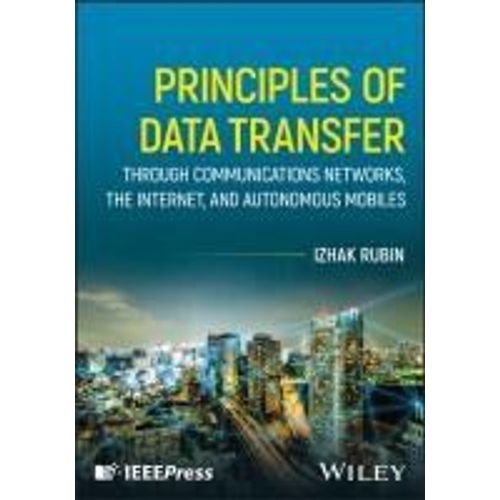

Principles of Data Transfer Through Communications Networks, the Internet, and Autonomous Mobiles - Rubin, Izhak
- Format: Relié
- 736.0 pages Voir le descriptif
Vous en avez un à vendre ?
Vendez-le-vôtreExpédition rapide et soignée depuis l`Angleterre - Délai de livraison: entre 10 et 20 jours ouvrés.
Nos autres offres
-
172,81 €
Produit Neuf
Ou 43,20 € /mois
- Livraison à 0,01 €
Nouvel article expédié dans le 24H à partir des Etats Unis Livraison au bout de 14 à 21 jours ouvrables.
-
211,40 €
Produit Neuf
Ou 52,85 € /mois
- Livraison à 0,01 €
Expédition rapide et soignée depuis l`Angleterre - Délai de livraison: entre 10 et 20 jours ouvrés.
- Payez directement sur Rakuten (CB, PayPal, 4xCB...)
- Récupérez le produit directement chez le vendeur
- Rakuten vous rembourse en cas de problème
Gratuit et sans engagement
Félicitations !
Nous sommes heureux de vous compter parmi nos membres du Club Rakuten !
TROUVER UN MAGASIN
Retour

Avis sur Principles Of Data Transfer Through Communications Networks, The Internet, And Autonomous Mobiles Format Relié - Livre
0 avis sur Principles Of Data Transfer Through Communications Networks, The Internet, And Autonomous Mobiles Format Relié - Livre
Donnez votre avis et cumulez 5
Les avis publiés font l'objet d'un contrôle automatisé de Rakuten.
Présentation Principles Of Data Transfer Through Communications Networks, The Internet, And Autonomous Mobiles Format Relié
- LivreAuteur(s) : Rubin, IzhakEditeur : WileyLangue : AnglaisParution : 01/01/2025Format : Moyen, de 350g à 1kgNombre de pages : 736.0 Résumé :List of Figures xv About the...

Résumé : List of Figures xv About the Author xxv Preface xxvi 1 Introduction: Networking in a Nutshell 1 1.1 Purpose 1 1.2 Networking Terms and Network Elements 2 1.3 Network Transport Processes 6 1.4 An Illustrative Transport Process: Sending Packages Across a Shipping Network 9 1.5 A Layered Communications Networking Architecture 14 1.6 Communications Network Architecture: User, Control, and Management Planes 27 1.6.1 Network Architectural Planes 27 1.6.2 The Data (User) Plane 29 1.6.3 The Control Plane 30 1.6.4 The Management Plane 33 1.7 Illustrative Network Systems 34 1.7.1 Highway Transportation 34 1.7.2 Inter-regional Road System 35 1.7.3 Train Transportation Network 35 1.7.4 Enterprise Computer Communications Network 35 1.7.5 Packet-Switching Network and the Internet 36 1.7.6 Cellular Wireless Networks 38 1.7.7 WiFi: Wireless Local Area Networks (WLANs) 40 1.7.8 Satellite Communications Networks 40 1.7.9 Autonomous Vehicular Networks 43 1.7.10 Sensor Networks and Internet of Things (IoT) 43 Problems 44 2 Information Sources, Communications Signals, and Multimedia Flows 47 2.1 End Users 47 2.2 Message Flows 48 2.3 Service Classes 51 2.4 Analog and Digital Signals 53 2.4.1 Analog and Digital Sources 53 2.4.2 Analog Signals 54 2.4.3 Digital Signals 54 2.4.4 Discretization: Analog-to-Digital Signal Conversion 55 2.5 Frequency Spectrum and Bandwidth 56 2.5.1 Time Domain and Frequency Domain 56 2.5.2 Frequency Spectrum of Periodic Signals 58 2.5.3 Frequency Spectrum of Nonperiodic Signals 59 2.5.4 Nyquist Sampling Rate 61 2.6 Audio Streaming 62 2.6.1 Audio Encoding and Streaming Across a Communications Circuit 62 2.6.1.1 Audio Encoding 62 2.6.1.2 Replay and Reconstruction of a Transported Stream 64 2.6.1.3 Transport of a Stream Across a Circuit-Switched Communications Network 66 2.6.2 Audio Streaming across a Packet-Switching Communications Network: Voice Over IP (VoIP) 68 2.6.2.1 Voice Over IP (VoIP) 68 2.6.2.2 The VoIP Streaming Process and the Realtime Transport Protocol (RTP) 70 2.6.2.3 Other CODECs and VOCODERs 73 2.6.2.4 Quality Metrics 75 2.7 Video Flows and Streams 77 2.7.1 Conversion of Light Waves to Electrical Signals 77 2.7.2 Digital Still Images 78 2.7.3 Full Motion Video 81 2.7.4 Video Compression 81 2.7.5 Transporting IP Video Streams over Communications Networks 83 2.7.6 Dynamic Adaptive Streaming over HTTP (DASH) 86 2.7.7 Performance Measures 87 2.8 Data Flows 88 Problems 90 3 Transmissions over Communications Channels 93 3.1 Communications Media 93 3.2 Wireline Communications Media 94 3.3 Wireless Communications Media 95 3.4 Message Transmission Over a Communications Channel 97 3.5 Noisy Communications Channels 98 3.6 Illustrative Calculation of Signal-to-Noise-plus-Interference Ratio (SINR) 102 3.7 Channel Capacity 104 3.8 Modulation/Coding Schemes (MCSs) 107 3.8.1 The Modulation Concept 107 3.8.2 Analog Modulation Techniques 108 3.8.3 Digital Modulation Techniques 110 3.8.4 Illustrative Digital Modulation/Coding Schemes 113 3.8.4.1 Modulation/Coding Schemes Used by a Wi-Fi Version 113 3.8.4.2 MCS Configurations for an LTE Cellular Wireless Radio Access Network 115 Problems 117 4 Traffic Processes 119 4.1 A Multilevel Traffic Model 119 4.2 Message Traff...
Biographie:
.
Détails de conformité du produit
Personne responsable dans l'UE
